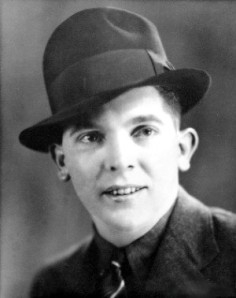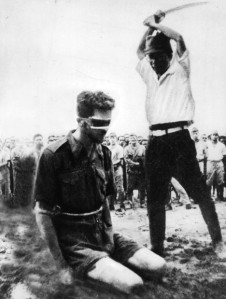Image: Decapitation at Aitape, 1943 October 24, 2010
Author: Beach Combing | in : Contemporary , trackback Beachcombing continues with his series of striking images. He is offering today though not the neat studio photograph of an Australian, Leonard Siffleet (1916-1943), opposite. But another more worrisome photograph of the same man that he has included in the middle of this post. There any reader, who feels up to it, will see the brave Australian serviceman about to be decapitated by a Japanese ‘Samurai’ at Aitape beach in 1943.
Beachcombing continues with his series of striking images. He is offering today though not the neat studio photograph of an Australian, Leonard Siffleet (1916-1943), opposite. But another more worrisome photograph of the same man that he has included in the middle of this post. There any reader, who feels up to it, will see the brave Australian serviceman about to be decapitated by a Japanese ‘Samurai’ at Aitape beach in 1943.
Please don’t write to Beachcombing afterwards and say that he ruined your sleep/digestion/working day: what follows is unpleasant and the sensitive would be well advised to avoid it and go and boil a potato instead.
Beachcombing apologises too to any Australian readers. He certainly does not intend to offend their sensibilities with this uncomfortable memory of an awful war.
Much as Beachcombing adores the Japanese – love hotels, Totoro, fish-flavoured liquorice… – he has always felt rather queasy about the whole Greater East Asia Co-Prosperity Sphere. Certainly, there is no denying that Japanese servicemen treated Allied prisoners of war with appalling callousness. Nor is there any question that the civilian populations of China and Allied civilian pockets in centres like Hong Kong and Singapore faced ‘institutionalised racism’ from their Japanese conquerors. (Nor is there any question that Allied soldiers paid Japanese soldiers back in kind…)
This leads us to Z Special Unit and M Special Unit, two Australian-led special operations groups to which Leonard Siffleet belonged. Siffleet, by all accounts a talented young officer, was trained by Z and then recruited into M (which specialised in reconnaissance) and sent to Papua New Guinea. There in October 1943 his small party watched Japanese sea traffic, until, only some days after they had established camp, they were captured by locals and handed over to the Japanese. The Japanese interrogated them for some two weeks before, 24 October, they were decapitated on the beach at Aitape.
Not the least extraordinary fact about Siffleet’s killing is that the Japanese soldier assigned to ‘execute’ him, Yasuno Chikao, asked for this photograph to be taken as a souvenir and that this photograph then became an ‘item’ among Japanese soldiers. In fact, the image came to light when it was found in the pocket of a dead Japanese soldier in the spring of 1944.
Of course, from there it made its way into Australian newspapers and even Life. One typical caption read as follows: ‘Within in a split second of the camera recording the scene, he was dead. He died alone, with his arms tied down to his sides with rope. He died when a Jap officer in lust and hatred swung a samurai sword and severed his neck at a stroke. He was entitled to the protection granted to men taken in war-a man whose simple rights are respected by all civilised peoples. In spite of this they led him out, blindfolded him and butchered him-with a circle of grinning yellow monkeys looking on. This is the enemy we now fight. An enemy without pity-with the bug of madness in his blood. Look long on this picture-and DO NOT FORGET.’
Here we have echoes of that unpleasant race hate that suffused so much Allied anti-Japanese propaganda and that actually led one US senator to present Roosevelt with a Japanese arm bone that had been made into a letter-opener.
The Japanese presumably in this case had decided that Siffleet was a spy and thus deserved to die, according to the rules of war: compare Hitler’s treatment of British and Dominion commandos – never-mind the uniforms that they had on. Disagreeable as this is, it is certainly quite different from some of the obscenities carried out by Japanese units elsewhere: e.g. the decapitation of about 200 injured Indian and Australian soldiers at Malay.
What Beachcombing struggles to understand is what decapitation meant to Japanese soldiers in the Second World War. Decapitation is often seen, in cultures from around the world, as an honourable death. As such a Japanese soldier killing an Australian in this manner might be taken as a – bizarre – form of compliment towards a courageous foe. Certainly Samurai were killed by decapitation after capture.
However, there is also plentiful evidence that the Japanese employed decapitation on Chinese civilian captives, where there is absolutely no evidence of respect.
For now Beachcombing is left with this image of Siffleet kneeling in the cold sand, thinking of his family in far away New South Wales. His position, the smiling crowd and his pinioned arms hardly suggest a going gently into that good night…
Beachcombing would also love to know more of the fate of Yasuno Chikao the sword-wielder: different sources give him different fates and someone with Japanese could surely uncover the truth here. Drbeachcombing at yahoo DOT com


